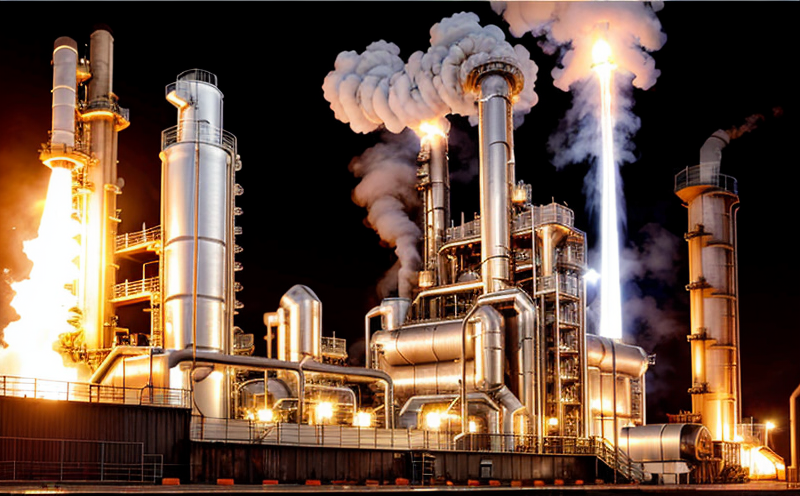ASTM E1086 Optical Emission Spectrometry of Stainless Steels
The ASTM E1086 standard specifies the procedure for determining the chemical composition of stainless steels using optical emission spectrometry (OES). This method is widely used in metallurgy and material testing to ensure compliance with specific alloy specifications. The test involves analyzing samples by generating light emissions when excited by an electric discharge, which are then measured against known standards.
The precision and accuracy of OES make it a preferred choice for routine compositional analysis in industries such as aerospace, automotive, electronics, and construction. For stainless steels specifically, this technique is invaluable for identifying the presence and concentration levels of critical alloying elements like chromium, nickel, molybdenum, and nitrogen.
The ASTM E1086 procedure allows laboratories to perform quantitative analysis on a wide range of stainless steel types, including martensitic, austenitic, ferritic, duplex, and precipitation-hardened grades. The testing process begins with the selection of appropriate standards based on the desired alloy composition. Specimen preparation typically involves cutting small sections from larger samples to ensure representative analysis.
The OES instrument used in this procedure consists of a high-voltage discharge lamp that excites the sample's atoms, causing them to emit light at specific wavelengths corresponding to each element present. A monochromator separates these emitted lines into their individual components for precise measurement. Data collected is then compared against reference spectra stored in the database.
One of the key advantages of using ASTM E1086 for stainless steel analysis lies in its ability to provide rapid results, typically within minutes per sample. This efficiency supports swift decision-making processes required by many industries. Additionally, the method offers high repeatability and reproducibility, ensuring consistent accuracy across multiple tests.
However, it's important to note that while OES provides excellent qualitative information regarding elemental content, quantitative precision can vary depending on factors like matrix effects or interference from other elements present in the sample. Therefore, laboratories must follow strict procedural guidelines closely aligned with the ASTM E1086 standard to minimize potential errors.
In summary, ASTM E1086 optical emission spectrometry plays a crucial role in ensuring consistent quality and compliance across various stainless steel applications by providing reliable compositional data essential for meeting stringent industry standards. Its versatility makes it suitable not only for routine inspections but also for research purposes aimed at optimizing material properties.
For those involved in quality management, compliance oversight, or R&D activities related to stainless steel fabrication, understanding the nuances of ASTM E1086 can be invaluable. By leveraging this methodology effectively, organizations can enhance their production processes, improve product performance, and maintain regulatory adherence more efficiently.
Industry Applications
The application of ASTM E1086 optical emission spectrometry extends beyond mere compliance checks; it serves as a cornerstone for quality assurance within several key sectors:
- Aerospace: Ensures that metallic components meet stringent weight-to-strength ratios critical for aircraft design.
- Automotive: Facilitates the development of lighter yet stronger vehicle parts through optimized alloy selection.
- Electronics: Supports miniaturization efforts by facilitating robust yet compact component manufacturing.
- BUILDING AND CONSTRUCTION: Guarantees durability and resistance against corrosion in infrastructure projects requiring long-term performance stability.
In each of these areas, accurate determination of stainless steel composition is paramount for achieving optimal product characteristics. Whether it's enhancing structural integrity or improving surface finish aesthetics, ASTM E1086 offers indispensable support towards meeting desired outcomes.
Customer Impact and Satisfaction
Leveraging the capabilities offered by ASTM E1086 optical emission spectrometry significantly enhances customer satisfaction across multiple dimensions:
- Quality Assurance: By ensuring that every batch of stainless steel meets specified chemical composition requirements, customers benefit from consistently high-quality products.
- Compliance: Meeting regulatory standards becomes easier and more reliable when relying on accurate testing methods like ASTM E1086. This reduces the risk of non-compliance penalties and associated costs.
- R&D Innovation: Researchers can explore new alloy formulations with confidence, knowing that compositional accuracy is guaranteed by this robust analytical tool.
- Safety: Ensuring that all materials comply with safety regulations helps protect end-users from potential hazards associated with substandard products.
Overall, the implementation of ASTM E1086 not only improves operational efficiency but also fosters trust between suppliers and their clients. This leads to stronger relationships built on mutual respect and shared goals for excellence in performance.
Competitive Advantage and Market Impact
The adoption of ASTM E1086 optical emission spectrometry provides significant competitive advantages that can translate into market leadership positions:
- Consistent Quality: Offering products with consistent chemical compositions differentiates your offerings from those produced by competitors who may not adhere to such stringent testing protocols.
- Innovation Lead: With access to precise compositional data, you can innovate faster and bring new alloys to market sooner than rivals lagging behind in analytical capabilities.
- Regulatory Compliance: Demonstrating robust compliance with relevant standards can build credibility among stakeholders, including customers, regulators, and investors.
- Premium Pricing: Higher perceived value from superior quality often translates into premium pricing strategies that attract discerning buyers willing to pay more for excellence.
By embracing ASTM E1086 optical emission spectrometry, companies not only stay ahead of the competition but also contribute positively to sustainable development goals by ensuring responsible use of resources and minimal environmental impact throughout manufacturing processes.





